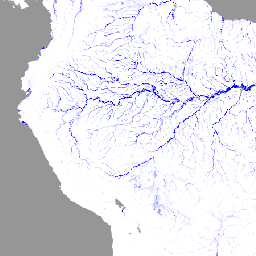
- 데이터 세트 사용 가능 기간
- 2010-01-01T00:00:00Z–2080-12-31T23:59:59Z
- 데이터 세트 제공업체
- World Resources Institute
- 태그
설명
Aqueduct Floods 데이터는 현재 기준 조건과 2030년, 2050년, 2080년의 미래 예측에 따라 하천 및 해안 지역의 홍수 위험을 측정합니다. Aqueduct Floods는 위험 지도를 제공하고 위험을 평가하는 것 외에도 제방 홍수 방지 전략의 가치를 평가하기 위해 포괄적인 비용 편익 분석을 수행하는 데 도움이 됩니다.
Aqueduct Floods는 재해 위험 분석가와 관리자에게 식량 위험 및 적응 전략 비용에 관한 정량적 정보를 제공하고 정책 및 투자 의사 결정을 지원하는 것을 목표로 합니다.
Google Earth Engine팀 권장사항:
이 데이터 세트는 다음 용도로 사용할 수 있습니다.
- 대규모 지역 분석: 미국 카운티 수준 / 대도시 크기의 넓은 지역에 대한 광범위한 위험은 무엇인가요?
- 예비 평가: 정확한 범람원 침수 지도가 필요하지 않고 하천 방류량의 잠재적 변화를 지역 규모로 신속하게 '첫눈'에 파악해야 하는 경우
- 상대적 변화: 다양한 기후 시나리오를 살펴보므로 영향의 크기 변화를 일반화하는 데 사용할 수 있습니다.
이 데이터 세트는 다음 용도로 사용하면 안 됩니다.
- 자세한 홍수 침수 매핑: 특정 속성 위험을 확인하는 등
- 평평한 저지대 강: 방정식의 단순화는 범람원에서 많이 발생하는 역류 효과 (물이 뒤로 흐르는 현상)를 고려하지 않습니다.
- 수력 구조 분석: 상당한 배수 효과를 유발하는 교량, 제방, 보와 같은 구조의 구체적인 영향을 평가하는 데는 적합하지 않습니다.
사용된 방법에 관한 자세한 내용은 데이터 제공업체의 기술 참고사항을 참고하고 이 데이터가 애플리케이션에 적합한지 확인하세요.
대역
픽셀 크기
1,000미터
대역
| 이름 | 단위 | 최소 | 최대 | 픽셀 크기 | 설명 |
|---|---|---|---|---|---|
inundation_depth |
m | 0* | 32.05* | 미터 | 홍수 침수 깊이 |
이미지 속성
이미지 속성
| 이름 | 유형 | 설명 |
|---|---|---|
| climatescenario | 문자열 | 기후 시나리오 유형:
|
| floodtype | 문자열 | 홍수 유형:
|
| 프로젝션 | INT | 해수면 상승 시나리오 (백분위수)
|
| returnperiod | INT | 반환 기간은 특정 규모 이상의 위험 이벤트 간에 예상되는 평균 시간 간격입니다 (단위: 년). 홍수 위험 지도는 1, 2, 5, 10, 25, 50, 100, 250, 500, 1000년의 반환 기간에 대해 생성됩니다. |
| 지반 침하 | 문자열 | inuncoast 홍수 유형에만 적용됩니다.
|
| 모델 | 문자열 | 하천 범람 유형에만 적용되며 사용된 모델의 유형을 나타냅니다.
|
| 년 | INT | 홍수 발생 연도 |
이용약관
이용약관
WRI 데이터 세트는 사용 또는 배포에 제한 없이 사용할 수 있습니다. WRI는 사용자가 적절한 출처 표시를 제공하고 해당되는 경우 WRI를 데이터 소스로 식별하도록 요청합니다. 자세한 내용은 WRI의 공개 데이터 약속을 참고하세요.
Earth Engine으로 탐색하기
코드 편집기(JavaScript)
var dataset = ee.ImageCollection('WRI/Aqueduct_Flood_Hazard_Maps/V2'); var inundationDepth = dataset.select('inundation_depth'); var inundationDepthVis = { min: 0, max: 1, palette: ['ffffff','0000ff'], }; Map.setCenter(-68.36, -6.73, 4); Map.addLayer(inundationDepth, inundationDepthVis, 'Aqueduct Flood Hazard Maps');
